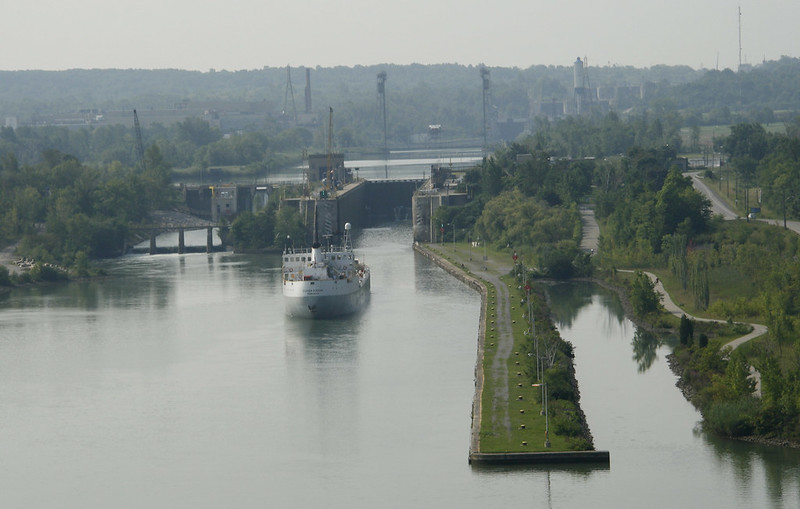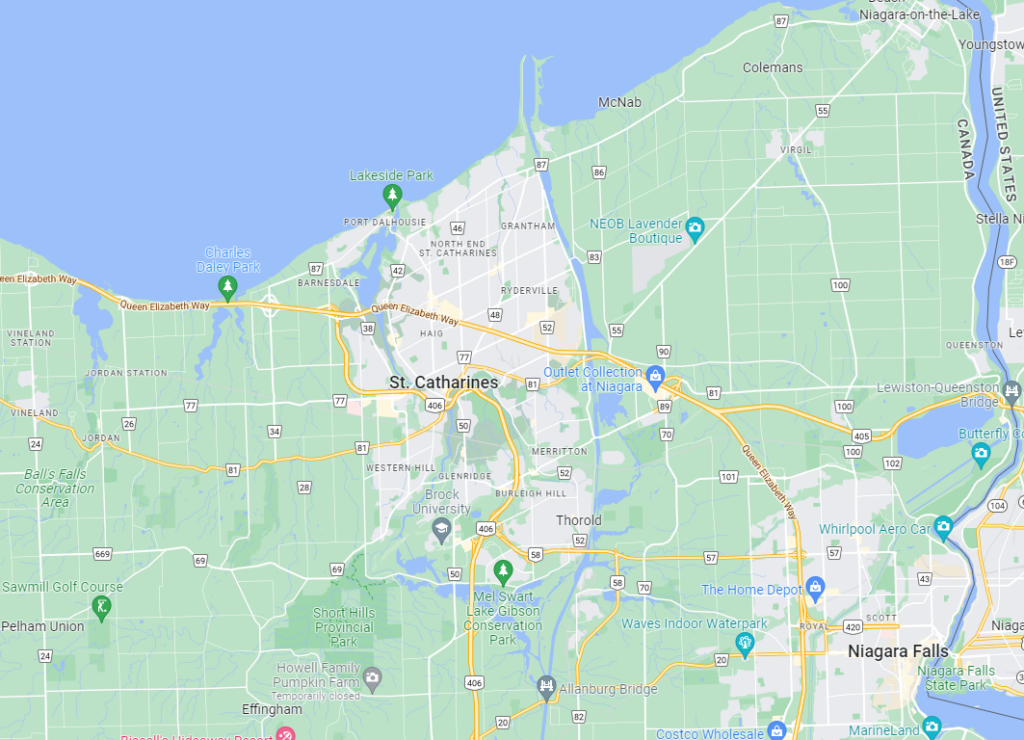The largest city in the Niagara Region and the sixth largest urban area in Ontario, St. Catharines is a multicultural city packed with economic opportunity, culture, history, and a close proximity to one of the wonders of the world – the world-famous Niagara Falls. A dynamic city, St. Catharines sits in the Golden Horseshoe on one of the key telecommunications junctions between Canada and the United States and has been designated as an Urban Growth Centre owing to its potential for growth.
Overview of St. Catharines Ontario
Filled with industry, hospitality, plenty of local services, recreation, and a great public transit system for a city of its size, St. Catharines enjoys a reputation for high quality of life and robust opportunity for development, both for individuals and their communities.
With a metropolitan population of 406,074, St. Catharines still enjoys a reputation for livability. It’s nicknamed “The Garden City” for the 4 square kilometers of trails, parks, and other greenspaces which bring a bit of the Niagara Region’s natural splendour to the city.
Under 20 kilometers away from the United States border and Niagara Falls, St. Catharines is well connected to Southern Ontario and destinations farther afield. Fortunately for residents, a bustling local economy means they can choose between a commuter lifestyle to neighbouring towns or take advantage of the opportunities which abound locally.

Read on to learn more about St. Catharines and the what its like to live in this city. If you’re considering real estate in the area don’t hesitate to reach out to one of our experienced associates to help you along your real estate journey.
The History of St. Catharines, Ontario
Before growing into the modern metropolis it is today, St. Catharines had humble beginnings as a small settlement of about 3,000 Loyalists in the late 1700’s. Due to the political situation at the time, people from around North America who were loyal to the Crown during the American Revolution sought a peaceful settlement where they could pursue their lives free of ideological persecution. For 3,000 people, that place was St. Catharines.
Here the Loyalists could peacefully work the land, cultivating the region’s fertile soils while taking advantage of the many waterways for Mill’s and transportation. These natural features made the site an attractive place to call home. At the turn of the century St. Catharines was growing as an agricultural centre, with a small service industry emerging to cater to travelers along the Indigenous trails along the Niagara Escarpment.
Later Development and Growth in St. Catharines
Before taking on the name it has today, St. Catharines was referred to as Shipman’s Corners after the owner of a prominent stagecoach transfer point. Despite the destruction brought on throughout much of the Niagara Region, Shipman’s Corners was spared thanks to its inland location.
The settlement’s natural advantages brought more prosperity as mills and the lumber industry made use of the area’s waterways, including Twelve Mile Creek. Yet the waterways were also used for another purpose. Salt springs along the river gave early St. Catharines a reputation as a health retreat.
From Settlement to the Village of St. Catharines
While the definite origin of the name St. Catharines isn’t certain, the village took this name around 1800. It’s thought that the name comes from the wife of a prominent local businessman. Regardless of the origin of its name, St. Catharines continued to prosper into the 19th century.
After the completion of the Erie Canal, a plan was devised to created a canal between Lake Erie and Lake Ontario to lessen the dependence on waterways controlled by the United States. Once completed, the Welland Canal continued to drive the village’s growth and St. Catharines became indispensable.

Following its incorporation as a town in 1845, St. Catharines was connected to Hamilton and Port Colborne by rail. The canal was replaced and expanded, further cementing the town’s strategic and economic importance.
Around the same time, residents took a renewed interest in agriculture and began using the land for fruit cultivation, a sign of what was to come with the Niagara Region’s reputation for wineries, vineyards, and orchards.
Harriet Tubman famously used St. Catharines as her home base for many years throughout the 50’s. Freedom seekers formed much of the local workforce, enjoying their prosperity and paving the way for generations to come. Today, several local churches are designed national historic sites. Visitors from around North America come to visit the site where famous abolitionists like Frederick Douglass once stood.
The Modern St. Catharines
Further infrastructure development in the latter half of the 1800’s attracted more residents. The town limits grew, and rural land began to be used for residential and commercial purposes. A slight slump in population occurred, mostly due to the relocation of shipyards and mills. Manufacturing took their place, especially in the 1900’s following the development of hydroelectric plants in the area.
Continued industrialization in the 20th century was responsible for future growth, and the postwar years introduced a shift towards suburban living and an improvement in quality of life. Several outlying towns were incorporated into St. Catharines by 1970’s, transforming it into the modern metropolis it is today.
Jobs and The Economy in St. Catharines, Ontario
While industry and agriculture historically drove growth and development in St. Catharines, there’s been a considerable shift towards tourism and hospitality in the 21st century. The Conference Board of Canada’s study of the region’s economy projects these sectors to play an even greater role in the city’s future.
Located just 20 kms from the border, both shipping and tourism account for much of St. Catharines economic opportunity. The Welland Canal remains a driving force in the local economy while serving a dual purpose as a tourist attraction in itself.
The city’s central location in the Niagara Region makes it a hub for tourism to local wineries, the famous falls, and even a stop for tourists looking to explore a part of Canadian history or enjoy the waterfront trail.
Recreation in St. Catharines, Ontario
Both indoor and outdoor recreation abound in St. Catharines for locals and tourists alike.
During the warmer months there are beaches, trails, parks, fishing, cycling, and even fishing to enjoy. Towns of its size are typically rife with municipal recreation program and facilities, and St. Catharines is no exception.
The Bruce Trail passes through the city, and it represents just a sliver of the options for nature lovers. Numerous parks and conservation areas are just a short drive away, and the downtown canal park is flanked on both sides by abundant greenspace that’s ideal for strolling, cycling, or enjoying a picnic.
When the weather turns cool residents can choose from numerous indoor facilities, sports leagues, and organized events and clubs.
Get the complete details on leisure and recreation in St. Catharines on the city’s leisure and recreation index.
Culture in St. Catharines, Ontario
Home to a unique culture, arts, and events scene, St. Catharines is also home to Brock University and all of the cultural cache it brings.
One of this city’s most prominent annual events is the Culture Days event, where attendees can enjoy free performances, workshops, and take in local art that represents St. Catharines cultural identity.
In addition to other numerous events throughout the year, regular fixtures on the local cultural scene include a centennial totem pole by a Kwakwaka’wakw artist, the world-class First Ontario Performing Arts centre, the Welland Canals Centre, downtown heritage sites and more. The aforementioned history of the Underground Railroad in St. Catharines is a highlight.
As a diverse and welcoming community, St. Catharines also offers plenty of opportunity to get involved and participate in some of the more local arts and culture programs. Downtown serves as the hub for arts and culture that’s incredibly accessible with fixtures like the local heritage buildings and farmers markets.
Browse the full list of arts and culture in St. Catharines here.
Real Estate in St. Catharines, Ontario
As a large metropolitan area, St. Catharines has the range of different types of real estate to suit most buyers. Ranging from high-density developments like condos to single-family fully detached homes, St. Catharines has it all and finding the type of property you’re looking for is just a click away with our custom property search tool.
Like many Ontario urban areas the city centre is characterized by more historic neighbourhoods with suburbs encircling them. These more modern developments extend mostly north and south of downtown, with the southern tip catering largely to Brock University, which is located there.
Despite its size, the majority of residents live in single detached houses, with other detached dwellings making up most of the remaining housing.
Interested in St. Catharines, Ontario real estate? Whether you’re looking for a new place to live or simply curious about the local market, let us know if you have any questions about real estate in the area.
You can also take advantage of our free MLS search tool to browse current listings for homes for sale in St. Catharines, Ontario.
Transportation in St. Catharines, Ontario
Getting around in St. Catharines is most comfortable and convenient in a personal vehicle, although the city has a comprehensive public transportation program to get you where you need to go. Affordable and accessible, the St. Catharines Transit Commission (STC) provides the safe, courteous, and reliable transportation befitting a city of its size.

Drivers can take advantage of one of three primary highways which criss-cross the city. These highways link St. Catharines with Niagara Falls in the south east and Hamilton in the north west. The highway to Hamilton will take you all the way to the GTA and beyond and grants access to numerous places along the way.
Inter city travelers seeking bus or train service can count on either GO Transit or VIA Rail to connect with the GTA and beyond. GO Transit is a great option for passengers who want direct routes to smaller local towns along the way.
Looking to Buy Real Estate in St. Catharines, Ontario?
Interested in learning more about real estate in St. Catharines? Use our custom property search tool to find the just type of property you’re interested in, browse listings in St. Catharines, or call us at (416) 917-5466 with questions.
Our friendly and knowledgeable associates are here to help you learn more about real estate in St. Catharines, Ontario and help you make the right decision when it comes to buying a home here.